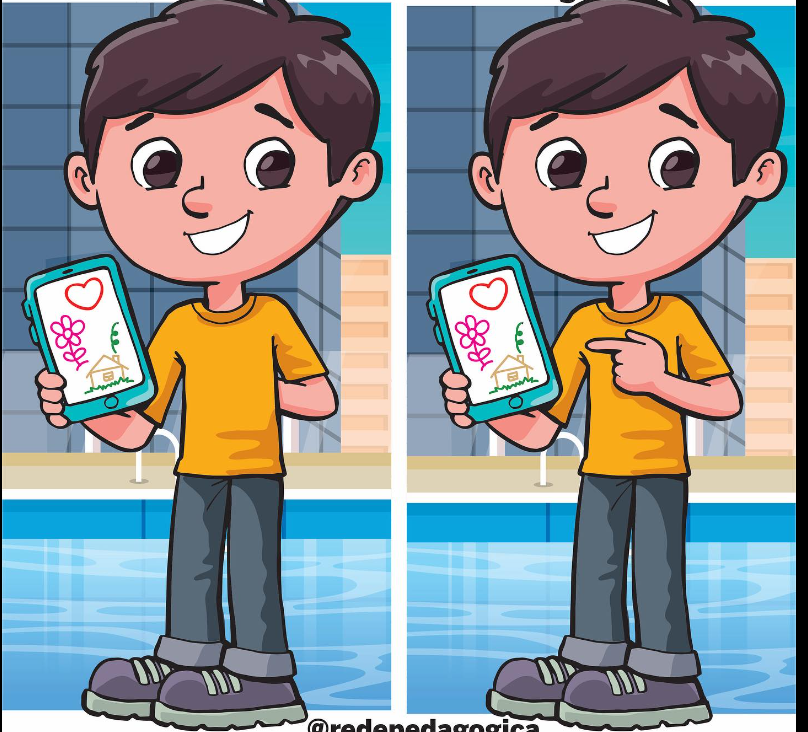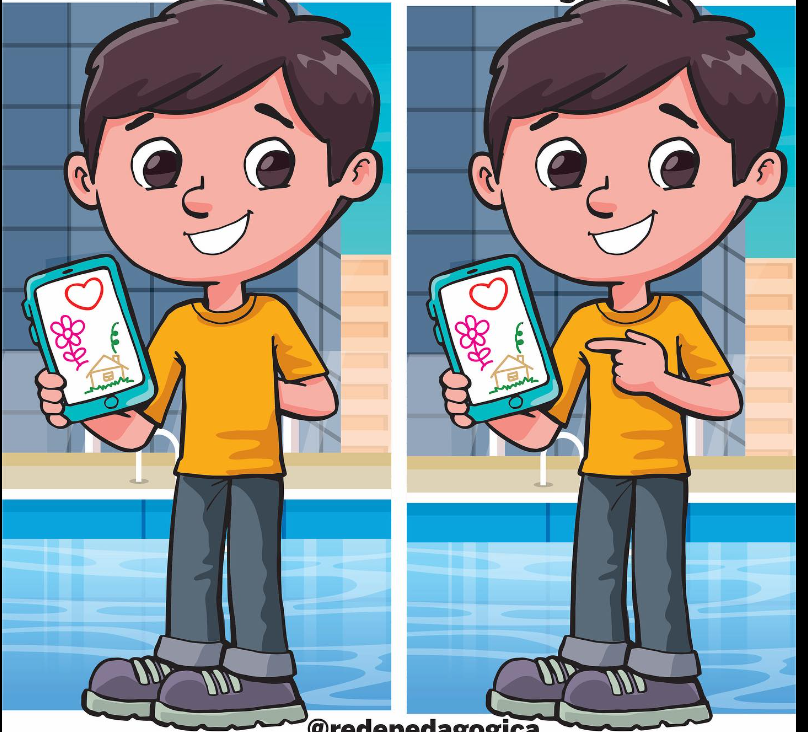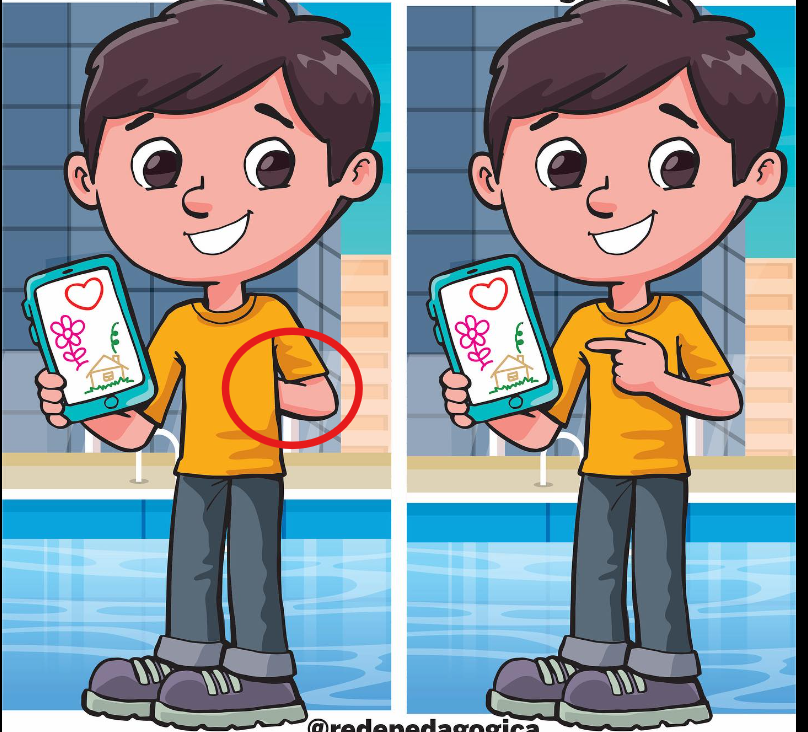Find the Hidden Differences in the Schoolyard Scene: A Fun Observation Challenge
Are you ready for an exciting challenge that tests your observation skills? In this article, we’ll dive into a delightful scene set in a schoolyard. But there’s a twist—two images seem identical at first glance, but they have subtle differences hidden in plain sight. Your mission is to find these differences, and trust me, it’s going to be a fun journey of discovery. Let’s take a closer look at the charming scene of a young boy proudly presenting his artwork to his friends and teacher.

A Picture of Joy: The Boy’s Proud Moment
In the middle of a bustling schoolyard, a young boy stands with a big smile on his face, holding up his smartphone. His small hand grips the phone tightly, showing off a drawing he’s created. The image on the screen features a lovely little house, topped with a bright red tile roof, and beside it, a large red heart against a blue sky. It’s simple yet filled with emotion—this drawing means a lot to him. It represents his family, love, and the joy of childhood.
The boy’s cheeks are rosy, and his eyes sparkle with pride. He’s excited to show off his creation, and the moment is clearly important to him. His short black hair is slightly tousled by the breeze, adding a playful touch to his appearance. He wears a white T-shirt adorned with a cheerful color print and a pair of bright blue shorts. There’s a sense of innocence and joy in the way he stands, beaming as he shares his artwork with those around him.
The Scene Around Him: Friends and Teachers Admire His Work
As the boy proudly holds up his phone, his friends and teacher gather around to admire his artwork. His friends can’t contain their excitement, shouting things like, “Wow, you draw so beautifully!” and “Does this house look like yours?” The boy nods eagerly, his face lighting up at the recognition. He explains that the house in his drawing is the one where he lives with his family—a place full of love, laughter, and warmth.
The large heart next to the house is a symbol of family love, and it represents the boy’s deep affection for his parents. It’s not just a drawing—it’s a heartfelt gift he wants to give to his family, something that shows how much he cares.
His teacher approaches with a smile, clearly impressed. “Your idea is very creative,” she says kindly, “What application did you use to draw?” The boy enthusiastically explains that he used a drawing app on his phone during break time to create the image. He shares with his teacher that he hopes his parents will love the picture, as it reflects his gratitude and love for them.
The teacher pats him on the shoulder and reassures him that his creativity will surely touch his parents’ hearts. The other children are also captivated, some even asking the boy to teach them how to create similar pictures. The excitement and admiration from his peers fill the air, creating a sense of community and shared joy.

The Boy’s Joyful Display: A Moment of Pure Happiness
The boy continues to hold his phone high, facing the sunlight. The screen reflects the shimmering light, causing the image of the house and heart to gleam with added brilliance. The schoolyard around him fades into the background as he becomes the bright spot in the scene. His smile, his pride, and the simple beauty of the moment create an unforgettable picture of childhood happiness.
As the boy stands there, surrounded by friends and teachers, the scene becomes a snapshot of pure joy and innocence. It’s the kind of moment that captures the essence of childhood—when everything feels new, exciting, and full of possibility. The boy’s connection to his artwork and the love it represents is evident in every expression and gesture.
Spotting the Differences: A Challenge of Observation
Now comes the fun part! You’ve observed the scene and soaked in the details, but here’s the twist: two versions of this image exist, and they’re not quite the same. Your task is to find the subtle differences between the two images. These differences might be small, but they are there, hidden in plain sight. The changes could be anything—maybe a shift in color, a change in expression, or even something in the background. It’s time to use your sharp observation skills and see if you can spot what’s different.
At first glance, the images might look almost identical. However, as you look closely, you’ll start to notice the little details that set them apart. This is a fun test of your ability to focus on the finer aspects of the scene, and it’s a great way to challenge your visual perception.

The Power of Attention to Detail: Why It Matters
Finding differences between two seemingly identical images isn’t just a fun activity—it’s also an excellent way to train your brain to focus on the little details that others might miss. Observation skills are incredibly important, whether you’re solving puzzles, studying a scene in a painting, or even navigating through life. The ability to notice subtle differences and nuances can lead to a deeper understanding of the world around you.
As you look at the images and compare them, take a moment to appreciate the intricate details that make each image unique. Maybe it’s the way the boy’s smile shifts slightly in one image, or the way the light reflects off his phone screen. These differences may seem small, but they add richness to the scene and show just how much thought and creativity went into creating it.
The Big Reveal: Discover the Difference
The moment you’ve been waiting for is finally here—the reveal! After carefully examining the images, the difference is now clear. While the two images seemed identical at first, one subtle detail stands out. It might be a change in the color of the boy’s T-shirt, or perhaps the position of a cloud in the sky. Whatever it is, the discovery of this difference brings the entire experience full circle.
Congratulations to those who successfully identified the difference! If you didn’t spot it this time, don’t worry—it’s all part of the fun. The key takeaway is that you’ve exercised your powers of observation and engaged with the puzzle, which is an accomplishment in itself.

Conclusion: The Joy of Observation and Discovery
This visual challenge has been more than just a puzzle—it’s been a fun exploration of the details that make a scene come alive. From the boy’s proud smile to the heartwarming symbolism in his drawing, the scene captures the essence of childhood joy and creativity. The task of finding the hidden differences has encouraged you to observe closely, focus on the subtle elements, and appreciate the beauty in every moment.
So, whether you found the differences or not, the most important thing is that you took part in the challenge and enjoyed the process. Keep practicing your observation skills—you never know when you’ll need them again, and with time, you’ll become an expert in spotting the smallest of details. Keep looking closely, and happy exploring!
















